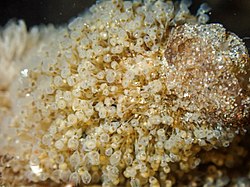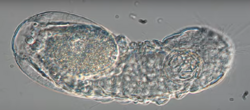List of bilaterian orders

Bilateria is an extremely diverse group of animals containing a vast majority of its species, largely due to the enormous amount of arthropods. This article is a list of orders contained within Bilateria separated by phylum. Groups that are not contained within an order are listed separately.
List
[edit]
Annelid taxonomy is currently under constant revisions due to the discovery that the class Polychaeta is paraphyletic. As such, a comprehensive list of orders is likely to change depending on what is accepted as valid.
Class Sipuncula
Clade Pleistoannelida
- Clade Errantia
- Myzostomida
- Clade Sedentaria
Unplaced groups
- Genus Apistobranchus
- Suborder Chaetopteriformia
- Suborder Cirratuliformia
- Genus Lobatocerebrum
- Clade Maldanomorpha
- Clade Paleoannelida
- Family Polygordiidae
- Family Siboglinidae[b]
Phylum Arthropoda
[edit]
Phylum Brachiopoda
[edit]
Class Craniata
Subphylum Linguliformea
- Class Lingulata
- Class Paterinata
Subphylum Rhynchonelliformea
- Class Chileata
- Class Kutorginata
- Class Obolellata
- Naukatida †
- Obolellida †
- Class Rhynchonellata
- Class Strophomenata

Class Gymnolaemata
Class Phylactolaemata
Class Stenolaemata
- Cyclostomatida
- Cryptostomata †
- Cystoporida †
- Esthonioporata †
- Fenestrata †
- Timanodictyina[c] †
- Trepostomatida †
Phylum Chaetognatha
[edit]
Unplaced groups
- Genus Capinatator
- Genus Eognathacantha
- Genus Protodagitta
- Genus Timorebestia

Phylum Cycliophora
[edit]
Class Eucycliophora

Dicyemida does not contain any established orders but does contain three families: Conocyemidae, Dicyemidae and Kantharellidae
Phylum Echinodermata
[edit]
Phylum Entoprocta
[edit]
Entoprocta has no orders but is split into four families; Barentsiidae, Pedicellinidae, Loxokalypodidae, and Loxosomatidae
Phylum Gastrotricha
[edit]
Phylum Gnathostomulida
[edit]
Phylum Hemichordata
[edit]
The classes Planctosphaeroidea and Enteropneusta do not contain any orders
Class Pterobranchia
- Cephalodiscida
- Subclass Graptolithina
- Rhabdopleurida
- Dendroidea †
- Graptoloidea †
Unplaced groups
- Family Cysticamaridae
- Family Wimanicrustidae
- Family Dithecodendridae
- Family Cyclograptidae
Phylum Kinorhyncha
[edit]
Class Cyclorhagida
- Echinorhagata
- Kentrorhagata
- Xenosomata
Class Allomalorhagida
- Anomoirhaga
Unplaced groups
- Genus Eokinorhynchus
- Family Pycnophyidae
Phylum Loricifera
[edit]
Loricifera has no classes and all species are contained within one order
Phylum Micrognathozoa
[edit]
Micrognathozoa has no classes and its single species is placed in one order


Nematode taxonomy is far from fully resolved, and different schemes might be used. For this list, Mike Hodda's Phylum Nematoda: a classification, catalogue and index of valid genera, with a census of valid species classification is used.[1]
Class Enoplea
- Subclass Enoplia
- Superorder Enoplica
- Alaimida
- Enoplida
- Ironida
- Trefusiida
- Tripyloidida
- Superorder Rhaptothyreica
- Rhaptothyreida
- Superorder Enoplica
- Subclass Oncholaimia
- Subclass Triplonchia
- Triplonchida
- Tripylida
Class Dorylaimea
- Subclass Dorylaimia
- Subclass Bathyodontia
- Bathyodontida
- Mononchida
- Mermithida
- Subclass Trichocephalia
- Trichocephalida
- Marimermithida
- Dioctophymatida
- Muspiceida
Class Chromadorea
- Subclass Chromadoria
- Chromadorida
- Selachinematida
- Desmodorida
- Desmoscolecida
- Subclass Plectia
- Superorder Monhysterica
- Superorder Plectica
- Superorder Teratocephalica
- Teratocephalida
- Superorder Rhabditica
- Diplogasterida
- Rhabditida
- Spirurida
- Rhigonematida
- Panagrolaimida
- Drilonematida
Phylum Nematomorpha
[edit]

Class Hoplonemertea
Class Palaeonemertea
- Archinemertea
- Carinomiformes
- Tubulaniformes
Class Pilidiophora
Phylum Onychophora
[edit]
Onychophora contains no classes and no orders, but is split into two living families; Peripatidae and Peripatopsidae, and 5 extinct genera; Antennacanthopodia, Antennipatus, Helenodora, Succinipatopsis, and Tertiapatus.
Phylum Orthonectida
[edit]
Orthonectida contains no classes or orders, but is split into two families; Pelmatosphaeridae and Rhopaluridae

Phoronida contains no classes, orders, or families, but is split into two genera; Phoronis and Phoronopsis
Phylum Platyhelminthes
[edit]
The class Catenulida contains no orders.
Subphylum Rhabditophora
- Clade Macrostomorpha
- Clade Trepaxonemata
- Gnosonesimida
- Clade Amplimatricata
- Clade Euneoophora
- Proseriata
- Rhabdocoela
- Clade Acentrosomata
- Clade Adiaphanida
- Clade Bothrioneodermata
- Bothrioplanida
- Superclass Neodermata
- Class Cestoda
- Subclass Cestodaria
- Subclass Eucestoda
- Class Monogenea
- Subclass Monopisthocotylea
- Monocotylidea
- Capsalidea
- Lagarocotylidea
- Montchadskyellidea
- Gyrodactylidea
- Dactylogyridea
- Subclass Polyopisthocotylea
- Subclass Monopisthocotylea
- Class Trematoda
- Subclass Aspidogastrea
- Subclass Digenea
- Class Cestoda
Unplaced groups
- Genus Haplopharynx
Phylum Priapulida
[edit]
Several stem group priapulid genera are not classified within any established orders. The orders listed below are solely crown priapulids.
- Halicryptomorphida
- Priapulimorphida
- Meiopriapulomorpha
- Seticoronaria[d]

The group Acanthocephala is traditionally treated as a separate phylum from Rotifera. However, it was found that Acanthocephala are phylogenetically contained within the rotifers, and this list reflects these findings.[citation needed]
Superclass Eurotatoria
- Class Bdelloidea
- Adinetida
- Philodinavida
- Philodinida
- Class Monogononta
Clade Acanthocephala
- Class Archiacanthocephala
- Class Eoacanthocephala
- Class Palaeacanthocephala
- Polyacanthorhynchida
Phylum Tardigrada
[edit]
The class Mesotardigrada contains one species, Thermozodium esakii, which has not been found since its reported discovery in 1937, and its existence is dubious. It is contained within the order Thermozodia.
Phylum Xenacoelomorpha
[edit]
The subphylum Xenoturbellida does not contain any classes or orders. It's only family is Xenoturbellidae which contains one genus, Xenoturbella.
- Subphylum Acoelomorpha
The class Nemertodermatida does not contain any orders, but does contain two families; Ascopariidae and Nemertodermatidae.
Notes
[edit]- ^ This order traditionally also includes the families Maldanidae and Arenicolidae, but is now believed to only contain Echiura and family Capitellidae. Maldanidae and Arenicolidae have been moved to the clade Maldanomorpha
- ^ This family is traditionally placed in the order Sabellida, but is now considered to be closest to Cirratuliformia and as such is now unplaced
- ^ May be a suborder of Cryptostomata
- ^ Sometimes treated as a class
References
[edit]- ^ Hodda, M. (2022). "Phylum Nematoda: a classification, catalogue and index of valid genera, with a census of valid species". Zootaxa. 5114 (1): 1–289. doi:10.11646/zootaxa.5114.1.1. PMID 35391386.
